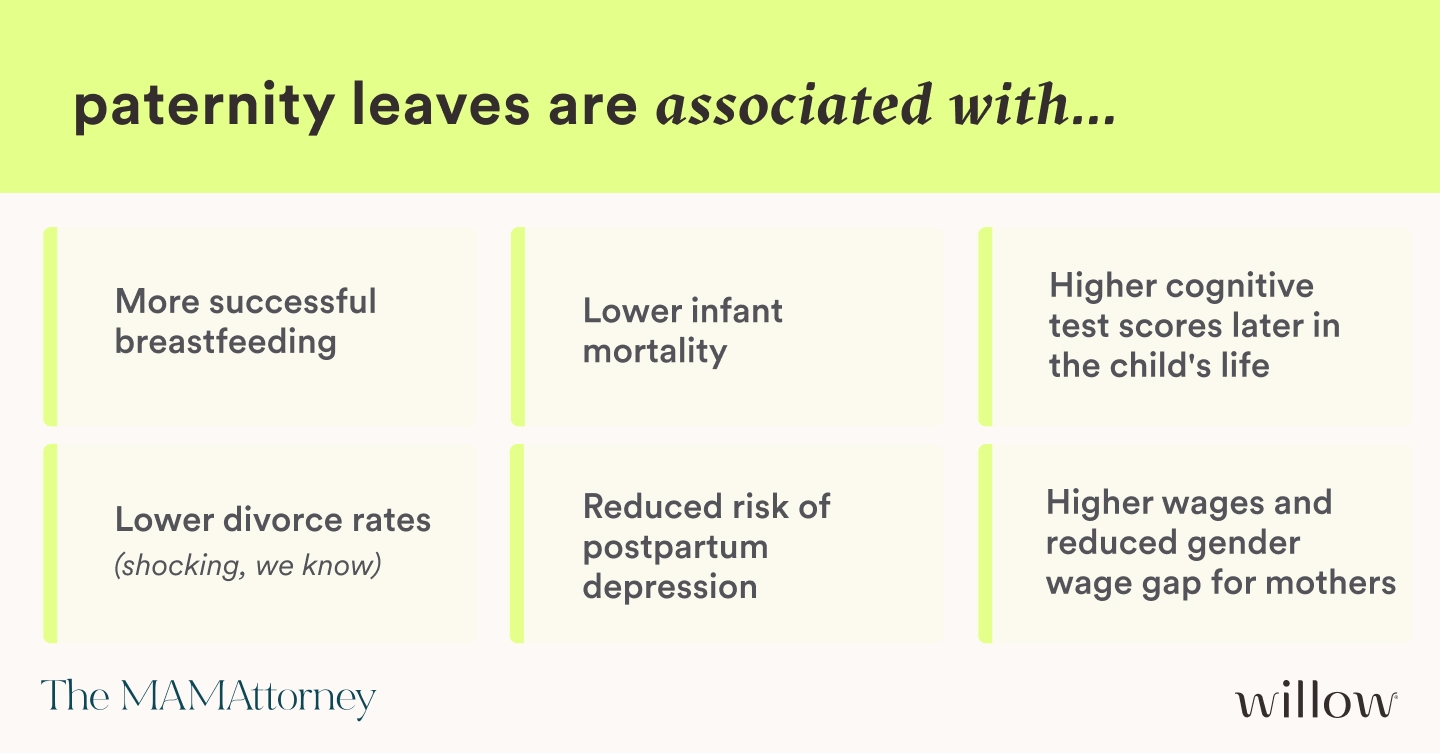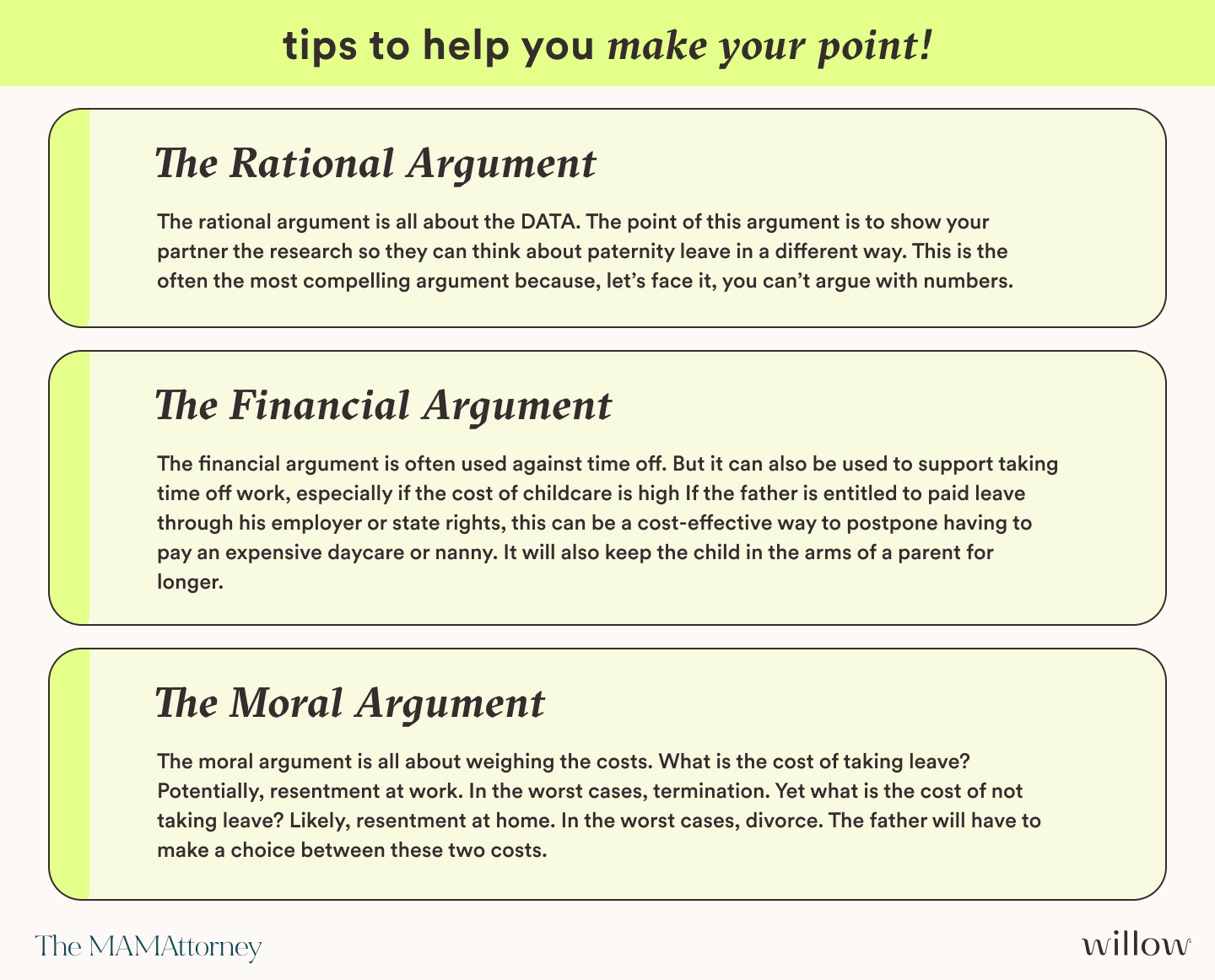“I feel like he abandoned me when I needed him the most.”
As an employment attorney supporting parents, paternity leave is a delicate topic. In this blog, I’ll share the most effective talking points to help convince your partner to take the leave, and tips to create a leave plan that will best support your family. He/she/they can then use these arguments to advocate for themselves at work—whoo!
It unfortunately remains the norm that fathers and non-birthing partners are expected to take little or no parental leave, and it can be exhausting to combat your partner and the status quo. So let me help! Buckle up… this is a long one.
I’ll share some of my own experiences as a husband/wife couple, some of my clients’ experiences, and refer to specific research, so some of the language may reference “father” as the non-birthing partner and use male pronouns, but this article applies to all parents. Specifically, having helped many same-sex couples navigate parental leave, I’ve noticed that same-sex couples receive even more pushback against a leave request. Managers may hold archaic views on the family structure, and the parents may experience a form of compounded discrimination.
This materializes in statements about caretaking, like telling fathers in a same-sex relationship, “Why do you both need time off? You didn’t even birth that baby,” or telling the non-birthing female parent, “Well, you didn’t give birth, so you don’t need any time off.” Research shows that same-sex couples receive less parental leave than different-sex couples.1 This is because of strong gender stereotypes where the non-birthing parent is expected to return to work within a day or two after birth, and the woman is assumed to be the primary caregiver.2
This may also affect adoptive or foster parents. In my experience, most employers simply do not know the rules on parental leave of non-birthing parents, and the parents may need to educate their own employers. There isn’t much research on parental leave in same-sex or adoptive/foster families, and the data below centers paternity leave, as the research has focused on different-sex couples. But I have seen in my own work that these parents want to take as much parental leave as possible, yet face a heightened challenge when advocating with their employers.
With all of that said, here are the arguments you can use, categorized by the direction and theme of the argument (hello, lawyer brain!), as not every person will respond to the same kind of arguments. Start with the rational argument, and go from there.

1. The Rational Argument
The rational argument is all about the DATA. The point of this argument is to show your partner the research so they can think about paternity leave in a different way. This is the often the most compelling argument because, let’s face it, you can’t argue with numbers.
- Longer paternity leaves are associated with higher cognitive test scores for the children later in life.3
- A Swedish study found that paternity leave resulted in increased chances of breastfeeding, and lower infant mortality.4
- Paternity leave leads to lower risk of divorce.5
- A lack of a father’s involvement after birth was a significant predictor of postpartum depression. This is something the couple never wants to experience the hard way. A woman reported to me that her husband returned to work right away, causing her to spiral into postpartum psychosis. Her husband ended up having to leave his job to care for her and the child for many months while she recovered.6
According to the research, 100% of the men were glad they took the leave, and 90% noticed an improvement in their relationship with their partner.7

The Financial Argument
The financial argument is often used against time off. But it can also be used to support taking time off work, especially if the cost of childcare is high. One woman reported to me that when she returned to work, her husband took leave, and they actually saved money. If the father is entitled to paid leave through his employer or state rights, this can be a cost-effective way to postpone having to pay an expensive daycare or nanny. It will also keep the child in the arms of a parent for longer.
Even better: paternity leave reduces the gender wage gap, resulting in greater long-term financial well-being.8 Accordingly, the financial penalty needs to be assessed in the aggregate. If the man doesn’t step up, the woman may lose her job, resulting in long-term financial distress for the family. Research shows that mothers’ incomes rose about 7% for each mother that a father spent at home on paternity leave.9
The Moral Argument
The moral argument is all about weighing the costs. What is the cost of taking leave? Potentially, resentment at work. In the worst cases, termination. Yet what is the cost of not taking leave? Likely, resentment at home. In the worst cases, divorce. The father will have to make a choice between these two costs. One mother reported that her partner was back to work the day after the birth. She said it left her absolutely destroyed and put her in a dark place. She explained the father regrets not taking more time off and continues to express feelings of having failed the family.
The Emotional Argument
The emotional argument answers the question: “What will we tell our child about this time?” It takes you out of the present moment and makes you think about what’s really important. Like my own husband said, “There is nothing more important than bonding with your child, and you want to be a partner to the person you call a partner. How can you call yourself a partner when you leave them when they need you the most? You are making the choice not to help them. You want to be able to tell your sons and daughters that you supported their mother, and wanted to spend time with them.”
The mother already carries the child, has to attend all the prenatal appointments, has to heal from birth, feed the baby with her body, and also put her career on hold. Women make enormous sacrifices to have children. It’s only fair that men make some compromises by sharing the burden of childcare.
The Legal Argument
The legal argument is your response to, “I don’t want to lose my job.” Firing someone for requesting or taking a lawful leave would be an unlawful termination, which means they could be entitled to a successful verdict or settlement. Not every man will want to go this route, but it can be empowering to know the law is on your side. Let’s be real: men do get fired for taking parental leave, or experience milder forms of retaliation. I know this because they call me. But it still happens.
Ironically, it’s precisely because men don’t take time off that women continue to suffer the impacts of gender discrimination. Mothers working full time are paid 71 percent as much as fathers.10 Taking time away from the workforce or cutting back hours hurt earnings.11 Women will keep bearing the brunt of discrimination if the burden of childcare falls entirely on them.12
It is unlawful to retaliate against an employee for taking a lawful leave. Partners have to stand firm in that, and they must take their FULL leave allotted by law. Anything less is them voluntarily forfeiting time they could be spending with their new child and supporting their partner.

The Societal Argument
The societal argument examines the bigger picture: if men don’t take leave, what is the point of paternity leave laws? Men need to take leave to challenge the norms. Any unused privileges at work will be cut back if the employees don’t take advantage of them. Many men don’t even know that they’re entitled to leave, and assume they have no rights.
Even in countries with more generous leave policies, leave is often not used. The UK introduced a shared parental leave policy allowing parents to split up to 50 weeks of leave between them. Research in 2018 showed that only 1% used the time, mainly because parents simply did not know the extent of their rights.13 The more men that take leave, the more men will know they can take leave.
Of course, there are some positive trends as well. In California (which has a paid paternity leave law) participation grew at a compound annual rate of 11.2 percent in 14 years.14 Even if women take advantage of the leave more than men, the balance is shifting: In 2004, the balance of women v. men was 84% women v. 16% men; in 2018, it was 62% women v. 38% men. The State of California promotes its paid leave program vigorously, even through paid ads on Instagram.
Paternity leave laws will be curtailed if they aren’t used, and there will not be an incentive to fight for stronger paid leave laws if men are not even taking leave. Men in management positions especially need to lead by example and show it can be done. Men often fear that the leave will breed resentment with their coworkers, but it’s the employer’s obligation to ensure proper staffing.
Giving early notice of the intention to take leave helps, as well as offering to train the replacement, finish projects early, or work a little bit more the weeks leading up to the leave. After representing hundreds of parents, I can assure you that it is extremely rare for an organization to fully fall apart when someone leaves. I’ve actually never heard of it. Someone will do the work that needs to get done. The world will keep turning without you there. The work will be there when you return, and someday, you can help another coworker take time off and encourage a culture where coworkers support each other.
As one woman reports, “My husband was considering taking only half his leave, even though he was entitled to 16 weeks. We had an extensive conversation about it. He ultimately understood there wouldn’t be a cultural shift around parental leave if men didn’t take what was offered. I like to think I empowered him to take it all and set a great example for his male and female colleagues alike.”
The Jugular
If all else fails… These are the shocker statements. It’s a sad truth that many women share that their partner’s lack of support postpartum resulted in the couple separating. They were never able to heal the wound of abandonment. The jugular option sounds like: “Paternity leave is cheaper than divorce.”
Be firm and unapologetic. Form a labor union of one and go on strike. Remember, this is his (her/their) baby too. As one mother reported. “We went out to dinner to discuss, and he pushed back when I asked him to take 3 weeks. I got so mad I stood up, 8 months pregnant, and walked 45 minutes home. I can still feel that anger. It took me walking out of dinner to get him to agree. Then he didn’t even take the time we agreed to. It set us up for years of resentment and Postpartum anxiety and depression (PPD/PPA). Now I don’t want to have another child. It almost ruined our marriage.”
How to Create a Joint Parental Leave Plan
It shouldn’t be up to the woman to do the emotional labor of planning leave for both partners. It should be a joint effort and start early. Your plan can be flexible, but you need to have a plan!
So here’s what to do:
-
Sit down together and review your employers’ parental leave policies. You may discover that you’re entitled to more time off than you initially thought, and you may have wage replacement options.
-
Research your state and city rights, as most leave rights are decided at the local level. The FMLA is a federal law, but isn’t the only option. Start early with this research—it’s dense and complex!
-
Know that your partner’s employer likely hasn’t actively promoted their paternity leave policy. But it’s often not up to the employer to decide whether to provide paternity leave; it’s up to the law, and employers must follow the law. If the father is entitled to a lawful leave, the employer can’t deny this request, even if it would be an undue hardship on the employer.
-
Don’t forget that they cannot negotiate if the law dictates a specific amount of time. They can’t say “We can’t accommodate 12 weeks, but we’ll give you 2.” It is simply not up to them.
-
Once you have a leave plan, write it out in an email and send it to your manager and HR. Make sure they confirm receipt of the plan. Do not skip this step.
-
If your spouse has no access to paid time off and going without a paycheck isn’t an option, can he request remote work or a part-time schedule? Some women reported that their spouses didn’t take leave, but did work from home more and worked during naps. To some women, this was a fair compromise.
In Conclusion
While we figure out our leave plans, we must keep advocating for paid leave for all. Whether the leave is paid is a huge factor to parents taking leave. Those living in paid leave states like California and Washington reported that it was much easier to take leave. Many parents reported they would have gladly taken more time off, but simply could not afford it. Some parents sold all of their furniture to be able to cover the wage gap.
In my research, one theme is constant: regret. Men end up regretting not taking paternity leave. Yet I’ve yet to meet a man who regretted taking paternity leave. This may be the strongest argument of them all.
REFERENCES
- Elizabeth Wong (2019), Comparing the availability of paid parental leave for same-sex and different-sex couples in 34 OECD countries, UCLA, Journal of Social Policy, Volume 49, Issue 3
- Id.
- Huerta et al.( 2013) “Fathers’ Leave, Fathers Involvement and Child Development.” OECD Social, Employment and Migration Working Papers.
- Månsdotter A, Lundin A, (2010) “How do masculinity, paternity leave, and mortality associate? A study of fathers in the Swedish parental & child cohort of 1988/89”, Soc Sci Med 2010;71:576–83
- Petts, Carlson and Knoester (2019) “Parental Leave and Marital Stability”
- Natalene Sejourne et al. (2012) “Effect of paternity leave on maternal postpartum depression” Gynecologie Obstetrique & Fertilite, June 2012, Volume 40
- Joint McKinsey (2020) “McGill University on paternity leave”
- Signe H. Andersen (2018) “Paternity leave and the motherhood penalty: New causal evidence,” Journal of Marriage and Family, October 2018
- Elly-Ann Johanssen (2010) “The effect of own and spousal parental leave on earnings” Institute for Labour Market Policy Evaluation working paper, number 2010:4
- National Women’s Law Center (2018) Motherhood Wage Gap for Mothers Overall: 2016 State Rankings
- Bertrand, M, Golding & Katz (2010) Dynamics of the gender gap for young professionals, American Economic Journal, Applied Economics, 2, 228-55
- Family Obligations Widen Gender-Based Pay Gap, Valentin Bolotnyy and Natalia Emanuel, “Why Do Women Earn Less Than Men?” (2018) Harvard Working Paper
- Holly Birkitt and Sarah Forbes, University of Birmingham (September 2018) Shared Parental Leave
- Cowan, Kallerman, The California Experience: Lessons from 20 Years of California’s Paid Leave Program (September 2021) , Bay Area Council Economic Institute













